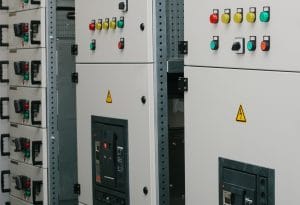 While electrical thermal management can have nearly endless connotations in today’s business environments, it’s most frequent and traditional application is in the cooling of electrical enclosures. The control panels and other enclosures that are essential to keeping electrical equipment safe must be continuously cooled to keep electrical waste heat from building up inside of them. For many modern companies that now enjoy the many benefits of streamlined cooling with advanced heat exchangers, the process of streamlining electrical enclosure cooling, specifically, has been one of the most important aspects of their operations.
While electrical thermal management can have nearly endless connotations in today’s business environments, it’s most frequent and traditional application is in the cooling of electrical enclosures. The control panels and other enclosures that are essential to keeping electrical equipment safe must be continuously cooled to keep electrical waste heat from building up inside of them. For many modern companies that now enjoy the many benefits of streamlined cooling with advanced heat exchangers, the process of streamlining electrical enclosure cooling, specifically, has been one of the most important aspects of their operations.
The importance of cooling electrical enclosures
Cooling electrical control panels and other enclosures is essential to maintaining any technology’s continued operations. Since companies in every industry began relying on technology to improve their overall operations, the need for efficient electrical cooling has been paramount. However, the difference is that modern applications often come with greater and more varying thermal management demands, and traditional cooling methods aren’t always the most efficient solution for meeting them. While largely effective, solutions such as air conditioners and air compressors, which cool electrical enclosures using chilled air, can also be highly reliant on energy and require frequent maintenance to sustain their operations.
The process of managing electrical waste heat
The need for solutions like air conditioners to produce and circulate chilled air for cooling enclosures stems from the vital need to prevent electrical overheating within the enclosures. The ultimate goal is to stop electrical waste heat from causing substantial damage to the sensitive components housed within the enclosure. However, with the advancement of technological solutions and the growth of smaller, more powerful, and more user-friendly applications, the process of cooling electrical enclosures had to become more efficient. Heat exchangers accomplished this by introducing more natural and efficient methods of cooling enclosures, focusing instead on continuously transferring waste heat rather than constantly overcoming it.
The advantages of modern cooling processes
When electrical enclosure cooling is achieved through natural heat transfer methods instead of more cumbersome mechanical ones, companies that rely on electrical cooling can experience several significant benefits. One of the most significant of these is the dramatically reduced amount of energy that heat exchangers require to transfer heat compared to that required by traditional solutions to generate and circulate chilled air. In addition to reduced energy needs and costs, the use of advanced heat exchangers for modern electrical enclosure cooling has also helped companies significantly streamline their overall operations.
For more information about the advanced state of modern electrical enclosure cooling, call Noren Thermal Solutions in Taylor, TX, at 866-936-6736.







